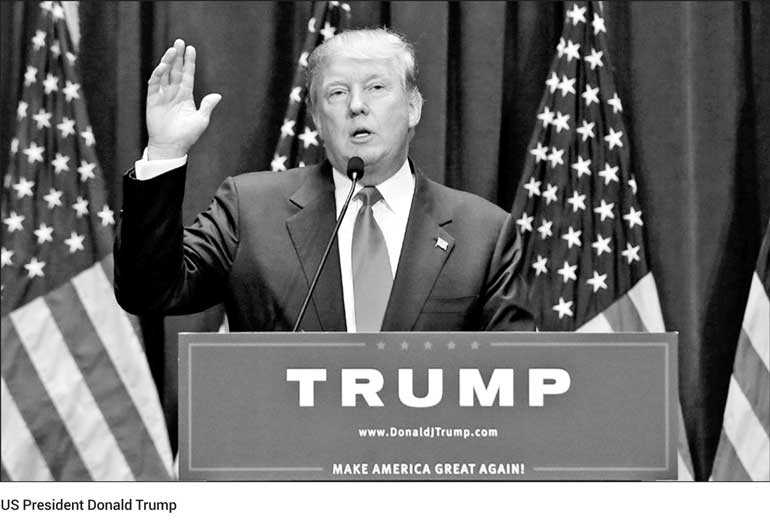Saturday Apr 19, 2025
Saturday Apr 19, 2025
Saturday, 16 February 2019 00:00 - - {{hitsCtrl.values.hits}}

 The talks over the “Wall of Trump” between the US-Mexico Border Security broke down with Congressional leaders over the weekend. After the renewed call for a wall at his second State of the Union, President Donald Trump attended a political rally in El Paso, a “safe” border city in Texas. Even with a Congressional deal, the White House intends to deploy the American military at the Mexican border and continues to threaten Congress that the President would declare a “National Emergency” to get his border wall.
The talks over the “Wall of Trump” between the US-Mexico Border Security broke down with Congressional leaders over the weekend. After the renewed call for a wall at his second State of the Union, President Donald Trump attended a political rally in El Paso, a “safe” border city in Texas. Even with a Congressional deal, the White House intends to deploy the American military at the Mexican border and continues to threaten Congress that the President would declare a “National Emergency” to get his border wall.
Characterising Trump’s exaggerated claims on border crimes and calling immigrants “rapists” and “animals,” Congresswoman Veronica Escobar representing El Paso called the president “a liar.” The bipartisan Congress does not also seem to fully fund the Trump wall.
Walls and nation-building
Long before Trump, however, there was an original love affair with China’s Great Wall. It was none other than Benjamin Franklin, the chief disciple of Confucius and chinoiserie among the Founding Fathers of the United States.
Unlike President Trump, Franklin was an American statesman who always had the veracity for facts and joined the military for national unity—a character of authentic Americanism to its founding conviction.
Soon after commissioning him as a military commander, Governor Robert Morris of the Pennsylvania Colony dispatched Franklin to defend the British colonists against the encroaching French and their Native American allies by building a “line of forts” in the French and Indian War (1754–1763). Envisioning a China Wall, Franklin wrote, “You cannot protect the country from Indians on the warpath by forts. They can pass between them through the forests, burn and pillage and massacre the people of the scattered villages, and return again in perfect safety. Only a Chinese wall the whole length of the Western frontier would be a sufficient protection against these savages.”
Once the war broke out in the Ohio River Valley in 1754, Pennsylvania was divided on a provincial security strategy. While some argued for carrying the war to the enemy, Governor Morris and Franklin advocated a defensive strategy with forts that “were connected by a wall like that of China.”
After building Fort Allen, Franklin supervised the construction of three other fortifications—Forts Franklin, Hamilton, and Norris—over the Blue Mountains of Pennsylvania. To galvanise public opinion to unite the colonies and defence against France, Franklin published a now-famous political cartoon in 1754, “Join or Die,” and wrote to support the construction of forts on “the Back of our Settlements in all our Colonies.”
Not everyone in colonial America agreed. In his letter to Franklin in 1776, the Chevalier de Kermorvan, a French engineer in the Continental Army under George Washington, disagreed arguing that “this work would be as useless here as the great wall of China, which has not preserved this empire from being conquered by the Tartars.” Likewise, in his exit interview General John Kelly, former Chief of Staff for President Trump, realised the futility of a wall when he concluded, “if you want to stop illegal immigration, stop US demand for drugs, and expand economic opportunity in Central America.” Unlike the American experience, however, the Great Wall of China was built by labourers with human tragedies over a period of two millennia, beginning roughly with the years of Confucius (551-479 BC). But, the Emperor Qin Shi Huang of the Qin dynasty (221-207BC) and the first emperor of the unified Imperial China connected a number of remaining network of fortifications into a single defensive system against the invading Mongol, Turkic, and other nomadic tribes. In the ensuing centuries, various dynasties continued to construct a strong defensive border-wall to safeguard against foreign invasion, regulate immigration, and manage trade until the Ming dynasty (1368-1644 AD). While it hardly prevented the non-Chinese nomadic intruders like the Mongols and Manchu from establishing the Yuan dynasty (1279–1368) and the Qing dynasty (1644-1912) respectively, the Great Wall has indeed played a historic role in unifying China and its national identity.
Walls of union and division
President Trump’s “immoral” campaign to build a “Great Wall” of concrete and steel across the US-Mexican border, on the other hand, has more to do with the white nationalism shrouded in the White House’s immigration policy. The President’s descriptions of invading “caravans” of migrants and “criminals” coming through the border and the arriving war refugees from Muslim countries seem to resonate with yet another “wall” sentiment of the nascent republic.
In considering the New York Constitution, for example, John Jay, who later became the first Chief Justice of the US Supreme Court, suggested that “we must erect a wall of brass around the country for the exclusion of Catholics,” who were generally meant to include French, Irish, Italians, and Spanish as opposed to white Protestants. The New York Constitution in 1777 adopted that freedom from “spiritual oppression and intolerance wherewith the bigotry and ambition of weak and wicked priest and princes have scourged mankind” and then declared “the free exercise and enjoyment of religious profession and worship, without discrimination or preference, shall forever hereafter be allowed, with this State, to all mankind.”
In politics now as it was then, the perennial debate over the inkling of a physical “wall” is still in the public discourse as it has always been with Thomas Jefferson’s metaphor of a “wall of separation” between Church and state. The American experiment born out of the Jeffersonian ideal that “all men are created equal” was meant to eventually make the new republic into a great melting pot. Unlike with the rising and falling empires of Chinese civilisation that has evolved, the US was created by the enlightened men envisioning a “philosophic empire” as a work-in-progress for the posterity to build a “more perfect union.”
Bridges not walls
Ironically, however, while Trump continues to advocate a “beautiful” wall, Chinese President Xi Jinping has delivered a clear message to the White House that “the wise man builds bridges, the fool builds walls.” Similarly, while visiting Panama last week, Pope Francis also remarked without directly referring to Trump that “we know that the father of lies, the devil, prefers a community divided and bickering” by building walls, not bridges.
In his farewell address, President Ronald Reagan invoked John Winthrop’s famous “Model of Christian Charity” phrase “shining city on a hill” to describe authentic Americanism when he said, “if there had to be city walls, the walls had doors, and the doors were open to anyone with the will and the heart to get here.” Surely, the American experience that progressed through the French and Indian War has made this Reaganite idea into a global nation—not a politically opportunistic slogan of “American First” with shameful “isolationism.”
As Congress contemplates the very idea of a wall and the cost of another government shutdown and national emergency, these representatives ought to remember that we are transitory guardians with diverse faith traditions on a land expropriated from the rightful owners of Native Americans; thus, they must restore the enlightened founding vision to make American democracy safe for global diversity. The Republican leaders should also educate Trump, reminding their inspired leader Reagan who said in 1987 to his Soviet counterpart at the Berlin Wall, “Mr. Gorbachev, tear down this wall.” That is authentic Americanism.
[Professor Patrick Mendis, the author of ‘Peaceful War,’ is a former American Field Service (AFS) inter-cultural exchange student from Sri Lanka to the United States and later adopted by the community of Perham in the state of Minnesota, which he considers his “birthplace” in America.]